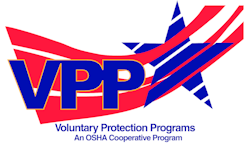The Voluntary Protection Program (VPP)
The Voluntary Protection Programs (VPP) recognize employers and workers in the private industry and federal agencies who have implemented effective safety and health management systems and maintain injury and illness rates below national Bureau of Labor Statistics averages for their respective industries.
To participate, employers must submit an application to OSHA and undergo a rigorous onsite evaluation by a team of safety and health professionals. Union support is required for applicants represented by a bargaining unit.
VPP participants are re-evaluated every three to five years to remain in the programs. VPP participants are exempt from OSHA programmed inspections while they maintain their VPP status.
Benefits
The VPP has a 20+ year history, and the average VPP worksite has a Days Away Restricted or Transferred (DART) case rate that is 52% below the average for its industry. VPP participation can also lead to lower employee turnover and increased productivity and cost savings.
OSHA VPP Star Status - Sturgeon Electric
In VPP, management, labor, and OSHA work cooperatively and proactively to prevent fatalities, injuries, and illnesses through a system focused on: hazard prevention and control; worksite analysis; training; and management commitment and worker involvement.
In practice, VPP sets performance-based criteria for a managed safety and health system, invites sites to apply, and then assesses applicants against these criteria. OSHA's verification includes an application review and a rigorous onsite evaluation by a team of OSHA safety and health experts.
Three Levels of Participation
OSHA approves qualified sites to one of three programs:
- Star: The Star Program is designed for exemplary worksites with comprehensive, successful safety and health management systems. Companies in the Star Program have achieved injury and illness rates at or below the national average of their respective industries. These sites are self-sufficient in their ability to control workplace hazards
- Merit: Merit is an effective stepping stone to Star. Merit sites have good safety and health management systems, but these systems need some improvement to be judged excellent. Merit sites demonstrate the potential and the commitment to meet goals tailored to each site and to achieve Star quality within three years.
- Star Demonstration: The Star Demonstration program is designed for worksites with Star quality safety and health protection to test alternatives to current Star eligibility and performance requirements. Promising and successful projects are considered for changes to Star requirements.
Knowledge Check Choose the best answer for the question.
6-1. Which VPP participation program indicates that the site has a good safety and health management system, but still needs some improvement to be judged excellent?
You forgot to answer the question!

